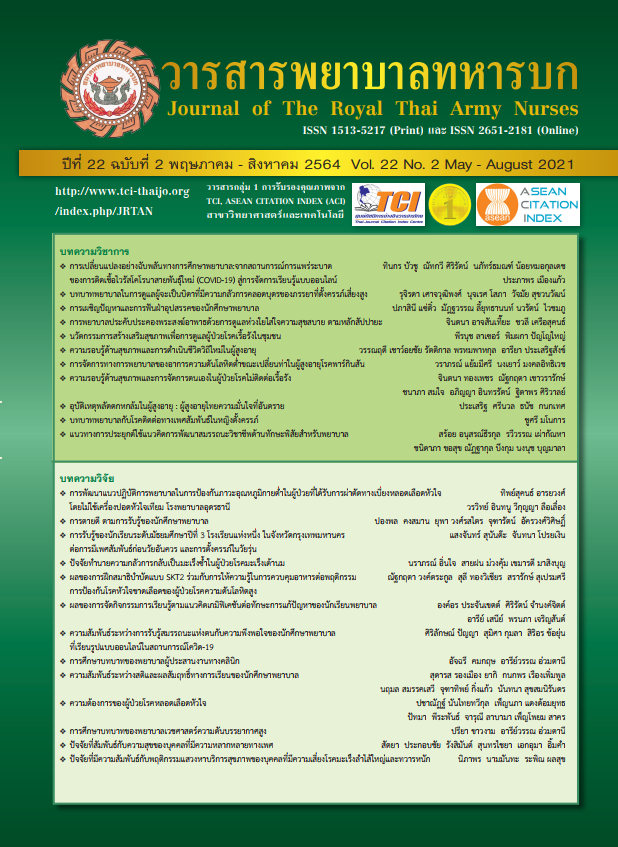The Factors Related to The Happiness among Sexual-and Gender-Diverse Persons
Keywords:
Happiness, Sexual diversity, Family relationship, Self-esteem, DepressionAbstract
This descriptive correlational researchwas examined the following: 1) the happiness among sexually- and gender-diverse individuals (SGD), and 2) the factors influencing the happiness of these individuals. One hundred and fifty-two sexually- and gender-diverse individuals were recruited. The instruments included the following: 1) a demographic characteristics questionnaire; 2) a family relationship questionnaire; 3) the Rosenberg Self-esteem Scale;4) the Center of Epidemiologic Studies Depression Scale (CSD-S), and 5) the Oxford Happiness Questionnaire. Cronbach’s alpha was used to determine the reliability of the instruments. Family relationship Questionnaire was at .75, Rosenberg Self-esteem scale was at.71, CES-D was at .80, and the Oxford Happiness Questionnaire was at .75. Data were analyzed using descriptive statistics and Spearman’s correlation coefficient.
The results revealed that the happiness was at a high level (M = 4.67, SD. = .59), family relationships were at a good level (M = 48.63, SD. = 7.17), self-esteem was at a high level (M = 3.30, SD. = .44), and depression was at 10.80 (SD. = 8.59). Family relationships and self-esteem had a statistically-significant positive relationship with happiness (r = .38, p<0.001, r = .66, p<.001), and depression had a statistically significant negative relationship with happiness (r = -.60, p<.001) Although happiness among SGD was at a high level, mental health nurses should develop nursing interventions by promoting family relationships and self-esteem. Moreover, depression is negatively correlated with happiness. Mental health nurses could early detect, prevent, and follow-up for depression among sexually-and gender-diverse persons.
Downloads
References
USAID. Being LGBT in Asia: Thailand country report: A participatory review andanalysis of the legal and social environment for Lesbian, Gay, Bisexual andTransgender (LGBT) Persons and Civil Society; 2014. Bangkok.
Meechumnan P. The Problem of disadvantage of sexual diversity because Thailand no Marriage Law; 2013. Chiang Mai University. (in Thai)
Srichannil N. Family, life and function issues of men who have sex with men. Bangkok: Mahidol University; 2010. (in Thai)
Suriyasarn B. Gender identity and sexual orientation in Thailand. Bangkok: International Labour Office; 2014. (in Thai)
Boonkerd S, Paikoh K. Mental health problem in female homosexual: Gender discrimination. J Royal Thai Army Nurses. 2017; 18(1): 15-21. (in Thai)
Payaksri S. Inequality of rights with sexual diversity. The 16th Graduate Seminar of Sociology and Anthropology report; 2017: 903-914.
Diener E. Subjective Well-Being: The Science of Happiness and a Proposal for a National Index. American Psychologist.2000; 55 (1): 34-43.
Barringer MN, Gay DA, Happily religious: The surprising sources of happiness among lesbian, gay, bisexual, and transgender adults. Sociological Inquiry. 2017; 87(1), 75-96.
Department of Mental Health. Annual report. Department of Mental Health Ministryof Public Health. 2015.
Pearkao P. Happiness among Thai kathoey, Gay. Journal of Nurses Association of Thailand, North-Eastern Division. 2013; 31(1): 142-149.
Ojanen TT, Ratanashevorn R, Boonkerd S. Gaps in responses to LGBT issues in Thailand: Mental health research, services, and policies. Psychology of Sexualities Review. 2016; 7(1): 41-59.
Myers DG, Diener E. Who is happy? Psychological Science. 1995; 6(1): 10-19.
Demir M. Friendship, need satisfaction and happiness. J Happiness Studies. 2010 Apr; 11(2):243-259.
Abdullah YA, ZulkifliFL, Concepts and theories of happiness in neighbourhood. Asian J Behav Studies, 2018; 3(12): 1-12.
Tato, R. Nursing research: Concepts to Application (2nd ed). Bangkok: Chulalongkorn University Press; 2009. (in Thai)
Jitaree B.The factors influencing depression amongst the elderly at a community in Nakhon Pathom Province. Nakhon Pathom: Christian University of Thailand; 2012. (in Thai)
Rosenberg MJ. Inconsistency arousal and education in attitude change. New York: Hot Rinehart and Winstom. 1965.
Yaowaluk M. The relationship between perception of bio-psychosocial change, self-esteemand health behavior of the elderly Amphur Maung, Sarabureeprovince. Bangkok: Mahidol University.1986. (in Thai)
KuptniratsaikulV, Pekuman P. The study of the Center for Epidemiologic Studies Depression Scale (CED-S) in Thai people. Siriraj Hosp Gaz:1997; 49(5): 42-448.
Wangmanee K. The development of happiness in Thai adolescents by self-harm program, Bangkok: Srinakharinwirot University; 2011. (in Thai)
Joseph L, Cranney S. Self-esteem among lesbian, gay, bisexual and same-sex-attracted Mormons and ex-Mormons. Mental Health, Religion andCulture. 2017; 20(10):1028-1041.
Ward RD, Winiger V, Higa KK, Kahn JB, Kandel ER, Balsam PD, Simpson EH, The impact of motivation on cognitive performance in an animal model of the negative and cognitive symptoms of schizophrenia. Behav Neurosci. 2015;129(4):292-299.
Barringer MN, Gay DA. Happily religious: The surprising sources ofhappiness among lesbian,gay, bisexual, and transgender adults. Sociological Inquiry, 2017; 87 (1): 75-96. doi:10.1111/soin.12154
National Statistical Office Thailand. Statistics of household incomereport: 2019. (in Thai)
Badgett MVL, Waaldijk K, Rodgers YVDM. The relationship between LGBT inclusionand economic development: Macro-level evidence, World Development, 2019; 120: 1-14.
Lelkes O. Happiness over the life cycle: exploring age-specific preferences. J Policy Brief March, 2008; 2:1-15.
Greene DC, Britton PJ. Predicting relationship commitment in gay men: Contributions of vicarious shame and internalized homophobia to the investment model. Psychol Men & Masculinity, 2015; 16(1): 78-87.
Katz-Wise SL, Rosario M, Tsappis M. Lesbian, gay, bisexual, and transgender youth and family acceptance. Pediatr Clin North Am. 2016; 63(6):1011-1025.
Haas AP, Eliason M, Mays M, Mathy RM, Cochran SD, D’Augelli AR, et al. Suicide and suicide risk in lesbian, gay, bisexual, and transgender populations: Review and recommendations. Journal of Homosexuality, 2010; 58(1): 10-51.
Downloads
Published
How to Cite
Issue
Section
License
บทความหรือข้อคิดเห็นใดใดที่ปรากฏในวารสารพยาบาลทหารบกเป็นวรรณกรรมของผู้เขียน ซึ่งบรรณาธิการหรือสมาคมพยาบาลทหารบก ไม่จำเป็นต้องเห็นด้วย
บทความที่ได้รับการตีพิมพ์เป็นลิขสิทธิ์ของวารสารพยาบาลทหารบก
The ideas and opinions expressed in the Journal of The Royal Thai Army Nurses are those of the authors and not necessarily those
of the editor or Royal Thai Army Nurses Association.






